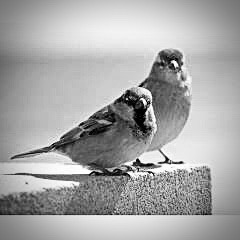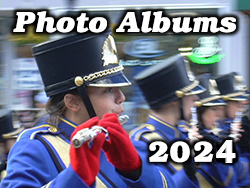
HOUSE SPARROWS (Passer domesticus)
As a young child growing up in the Bronx, I was fascinated by the house sparrows that nested in the signs above our local supermarkets, frantically swooping down to the ground, gleaning and back up to their nests. Although I didn’t realize it at the time, I was watching one of the oldest and most successful relationships between humans and animals, house sparrows.
House sparrow (Passer domesticus) is one of the most common animals in the world. It is found throughout Northern Africa, Europe, the Americas and much of Asia and is almost certainly more abundant than humans. The birds follow us wherever we go. House sparrows have been seen feeding on the 80th floor of the Empire State Building. They have been spotted breeding nearly 2,000 feet underground in a mine in Yorkshire, England. If asked to describe a house sparrow, many bird biologists would describe it as a small, ubiquitous brown bird, originally native to Europe and then introduced to the Americas and elsewhere around the world, where it became a pest of humans.
The problem with sparrows is that the story of their marriage with humanity is ancient and so, like our own story, only partially known.
Many field guides call the house sparrow the European house sparrow or the English sparrow and describe it as being native to Europe, but it is not native to Europe.
The clan of the house sparrow appears to have arisen in Africa. The first hint of the house sparrow itself is based on two jawbones found in a layer of sediment more than 100,000 years old in a cave in Israel. The bird to which the bones belonged was a pre-domestic sparrow, although it has been speculated that even this bird might have associated with early humans, whose remains have been found in the same cave. The fossil record is then quiet until 10,000 or 20,000 years ago, when birds very similar to the modern house sparrow begin to appear in the fossil record in Israel.
House sparrows were so common in Israel they are mentioned in the Bible. “For only a penny you can buy two sparrows, yet not one sparrow falls to the ground without your Father’s consent. Matthew 10;20
Once house sparrows began to live among humans, they spread to Europe with the spread of agriculture and, as they did, evolved differences in size, shape, color and behavior in different regions. As a result, all of the house sparrows around the world appear to have descended from a single, human-dependent lineage, one story that began thousands of years ago. From that single lineage, house sparrows have evolved as we have taken them to new, colder, hotter and otherwise challenging environments, so much so that scientists have begun to consider these birds different subspecies.
As for how the relationship between house sparrows and humans began is unknown. What is clear is that eventually sparrows became associated with human settlements and agriculture. Eventually, the house sparrow began to depend on our gardened food so much so that it no longer needed to migrate. The house sparrow, like humans, settled. They began to nest in our habitat, in buildings we built, and to eat what we produce (whether our food or our pests).
When Europeans first arrived in the Americas, there were none of the species Europeans had come to expect in cities: no pigeons, no sparrows, not even any Norway rats. Even once European-style cities began to emerge, they seemed empty of birds and other large animals. In the late 1800s, a young visionary, Nicholas Pike, imagined that what was missing were the birds that live with humans and, he thought, eat our pests. Pike, about whom little is known, introduced about 16 birds into Brooklyn. They rose from his hands and took off and prospered. Every single house sparrow in North America may be descended from those birds. The house sparrows were looked upon favorably for a while until they became abundant and began to spread from the New York to California. In 1889, just 49 years after the introduction of the birds, a survey was sent to roughly 5,000 Americans to ask them what they thought of the house sparrows. Three thousand people responded and the sentiment was nearly universal: The birds were pests.
House sparrows are often blamed for declines in the abundance of native birds, such as bluebirds, though the data linking sparrow abundance to bluebird decline are sparse. The bigger issue is that we have replaced bluebird habitats with the urban habitats house sparrows favor as we have been doing for tens of thousands of years.
House sparrows have become more rare in Europe for the first time in thousands of years. In the United Kingdom, for example, numbers of house sparrows have declined by 60 percent in cities. As the birds became rare, people began to miss them again. In some countries the house sparrow is now considered a species of conservation concern. Newspapers ran series on the birds’ benefits. One newspaper offered a reward for anyone who could find out “what was killing our sparrows. Then just this year a plausible (though probably incomplete) answer seems to have emerged. The Eurasian sparrowhawk (Accipiter nisus), a hawk that feeds almost exclusively on sparrows, has become common in cities across Europe and is eating the sparrows. Some people have begun to hate the hawk.
When I began this article, I didn’t know how I could make the House Sparrow sound interesting. Now after researching this article by Rob Dunn and others I plan to follow up with more information on the fascinating story of the ‘common house sparrow’ and its incredible success.
In the end, I can’t tell you whether sparrows are good or bad. I can tell you that when sparrows are rare, we tend to like them, and when they are common, we tend to hate them. Our fondness is fickle and predictable and says far more about us than them. They are just sparrows. They are neither lovely nor terrible, but instead just birds searching for sustenance and finding it again and again where we live. Now, as I watch a sparrow at the feeder behind my own house, I try to forget for a moment whether I am supposed to like it or not. I just watch as it grabs onto a plastic perch with its thin feet. It hangs there and flutters a little to keep its balance as the feeder spins. Once full, it fumbles for a second and then flaps its small wings and flies. It could go anywhere from here, or at least anywhere it finds what it needs, which appears to be us.
Rob Dunn is a biologist at North Carolina State University and the author of The Wild Life of Our Bodies. He has written for Smithsonian about our ancestors’ predators, singing mice and the discovery of the hamster.
Enjoy your garden all year long,
James





